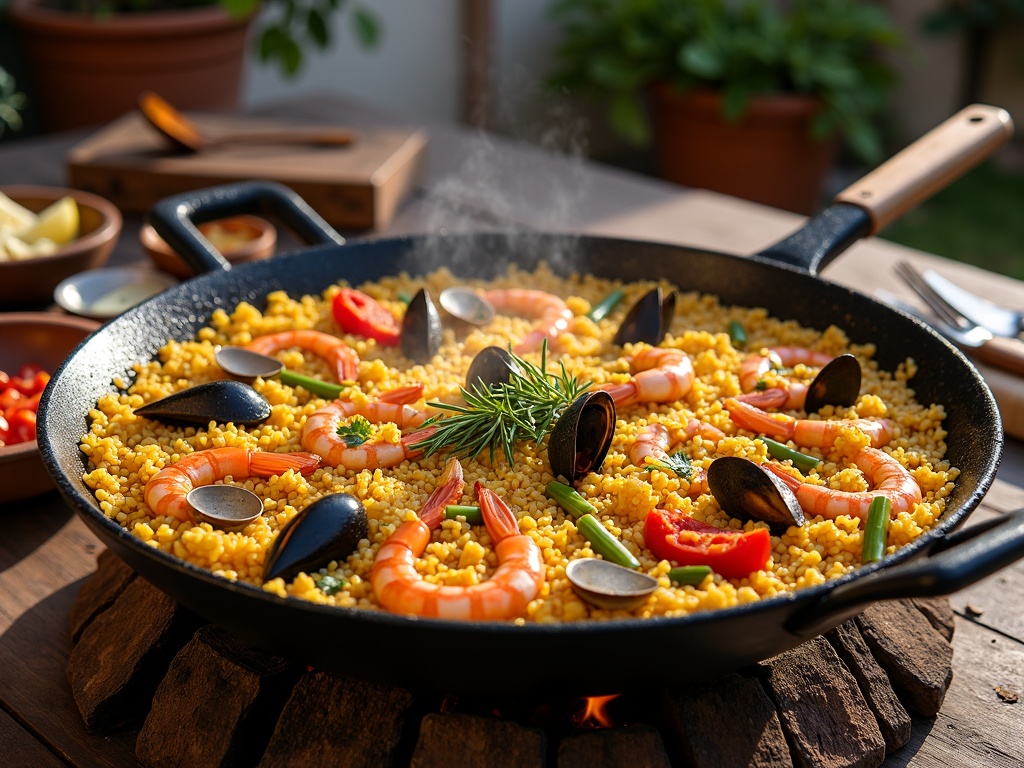Paella: Spain’s Iconic Rice Dish
Paella Recipe, Spain’s iconic rice dish from Valencia, combines regional ingredients cooked in a wide, shallow pan to create the coveted socarrat (crispy bottom layer). The traditional cooking method transforms basic ingredients into a cultural celebration, with families eating directly from the pan in a communal dining experience that has shaped Spanish cuisine for centuries.
Table of Contents
Key Takeaways
- Authentic paella requires specific ingredients like Bomba or Calasparra rice and saffron threads, which give the dish its distinctive golden color and flavor.
- The traditional wide, shallow paella pan (paellera) is crucial for developing the prized socarrat, though large cast-iron skillets can serve as alternatives for home cooking.
- Proper technique includes creating a sofrito base, adding hot stock, and avoiding stirring after the stock is added to allow the crispy bottom layer to form.
- Timing the addition of proteins is essential – start with longer-cooking items and add quicker-cooking seafood in the final minutes.
- Paella components can be prepped ahead of time, making this impressive dish manageable for home cooks while maintaining authentic flavor.
What Makes Paella Recipe So Special
Paella Recipe stands as Spain’s culinary crown jewel, originating in the Valencia region during the 18th century. Farm laborers would cook this rice dish outdoors over open fires, combining local ingredients they had on hand. The name “paella” actually comes from the specialized wide, shallow pan used to cook it, which allows the rice to cook evenly and develop the cherished socarrat (crispy bottom layer) that’s so prized in authentic versions.
Traditional Cooking Methods and Cultural Significance
The traditional preparation of paella is almost ceremonial in nature. I’ve found that authentic paella recipe is cooked over an open flame, often using orange wood which imparts a subtle aromatic quality to the dish. The wide paella pan is crucial, allowing rice to spread thinly and cook uniformly. In Spain, paella isn’t just food—it’s a celebration, typically prepared for Sunday family gatherings where everyone shares directly from the pan at the center of the table.
What truly sets paella apart from other rice dishes like flavorful chicken biryani is its cultural foundation. It reflects the Spanish value of gathering loved ones around a shared meal, creating an experience that nourishes both body and community bonds. Each region in Spain has its own variation, showcasing local ingredients and preferences—coastal areas feature seafood, while inland versions might include rabbit, chicken, and snails.
Perfect for Home Cooking
I’ve adapted this traditional dish to make it accessible for home cooks without sacrificing authenticity. Here’s why this recipe works so well in a home kitchen:
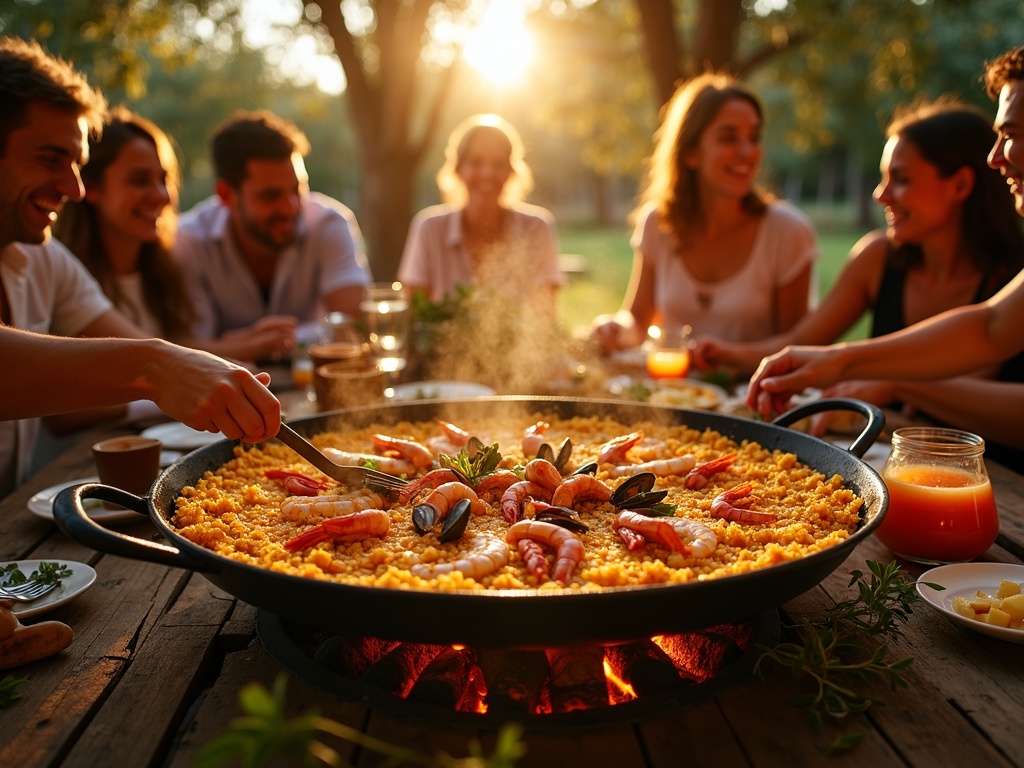
- Equipment flexibility – While a paella pan is ideal, a large, shallow skillet works nearly as well for smaller batches
- Ingredient adaptability – The recipe allows for seasonal substitutions while maintaining the dish’s character
- Clear visual cues – I’ve included specific indicators to help you achieve that perfect socarrat without specialized equipment
- Simplified process – The traditional technique has been streamlined without losing the essential flavors
Unlike complex dishes that require advanced techniques, paella builds flavor through simple steps that any home cook can master. The key is understanding how to layer flavors and when to leave the rice undisturbed. This approach creates results similar to other Mediterranean classics like rustic ratatouille or refreshing gazpacho, where simple ingredients transform into something extraordinary.
I’ve found that home cooks particularly appreciate how paella, despite its impressive presentation, can be made in a single pan with manageable prep work, making cleanup much easier than other special-occasion dishes.
Essential Ingredients for Authentic Paella Recipe
Creating a genuine paella starts with having the right ingredients. I’ve found that authentic paella relies on specific components that bring together the distinctive flavors of this iconic Spanish dish.
The Foundation: Rice and Saffron
Bomba or Calasparra rice forms the heart of any authentic paella recipe. These short-grain Spanish rice varieties have an exceptional ability to absorb liquid while maintaining their structure. Unlike regular rice, Bomba can absorb nearly three times its volume without becoming mushy—perfect for soaking up all those delicious flavors.
Saffron threads are non-negotiable for traditional paella, giving the dish its characteristic golden hue and distinct aromatic flavor. Though expensive, you only need a small amount—about 1/4 teaspoon of threads for a typical paella serving 4-6 people. For best results, I crush the threads and steep them in hot water or broth for about 10 minutes before adding to the rice.
Building Flavors: Proteins, Vegetables and Stock
Fresh seafood transforms an ordinary rice dish into a coastal Spanish masterpiece. Consider these options:
- Shrimp or prawns (shell-on provides more flavor)
- Mussels and clams (cleaned thoroughly)
- Squid or calamari (sliced into rings)
- Firm white fish like monkfish or sea bass (cut into chunks)
The vegetable foundation starts with the sofrito—a sautéed mixture of aromatics that includes:
- Onions (finely diced)
- Garlic (minced fresh)
- Bell peppers (preferably red for sweetness and color)
- Tomatoes (grated or finely chopped)
A well-prepared stock makes the difference between good and exceptional paella recipe. Fish stock works beautifully for seafood paella, while chicken stock pairs well with meat versions. The stock should be hot when added to the rice to ensure even cooking.
Key seasonings include:
- Spanish paprika (sweet or smoked)
- Bay leaves
- Fresh rosemary sprigs
- Salt and freshly ground black pepper
For an additional layer of flavor, try adding artichoke hearts, green beans, or fresh herbs like parsley near the end of cooking. Some regions also include lemon wedges served alongside the finished dish.
I find that preparing all ingredients before starting to cook makes the process much smoother. While ingredient quality matters tremendously, don’t forget that the cooking technique—particularly achieving that prized socarrat (crispy bottom layer)—is equally important to creating an authentic rice dish that would make any Spanish grandmother proud.
Equipment You’ll Need
I’ve found that having the right tools makes all the difference when preparing an authentic paella. While traditional methods require specific equipment, I’ll share some practical alternatives that work just as well.
Traditional Paella Pan and Alternatives
The star of paella-making is undoubtedly the paellera – a wide, shallow pan with slightly sloped sides. This design allows rice to cook evenly in a thin layer, creating that perfect socarrat (crispy bottom layer) that paella enthusiasts crave. If you don’t have a paellera, don’t worry! I’ve successfully used these alternatives:
- Large cast-iron skillet: Retains heat beautifully and creates an excellent socarrat
- Wide, shallow stainless steel pan: Works well if at least 13 inches across
- Large non-stick skillet: Not ideal for socarrat but still makes tasty paella
- Wok: The sloped sides aren’t traditional but can work in a pinch
When selecting a pan, I look for one that’s wide rather than deep – ideally 15–18 inches for feeding 4–6 people. For smaller gatherings, a 13-inch pan works perfectly for 2–3 servings.
The heat source matters significantly. Traditional paella recipe is cooked over an open flame that distributes heat across the entire pan. At home, I spread the pan across two burners, rotating it occasionally for even cooking. For outdoor cooking, a grill or portable gas burner provides the most authentic results with that smoky flavor that complements the Spanish cuisine beautifully.
Essential Utensils
Don’t forget these essential utensils:
- Long-handled wooden spoon for stirring without scratching
- Metal spatula for checking and serving the socarrat
- Ladle for adding broth gradually
- Aluminum foil for covering the pan when needed
Size considerations are practical – a 13-inch paella pan serves 2–3 people comfortably, while a 15-inch feeds 4–5, and an 18-inch works for 6–8 guests. I’d rather use a slightly larger pan than crowd ingredients in a small one, as rice needs space to cook properly.
If you’re entertaining regularly, investing in a proper paella pan makes sense. They’re surprisingly affordable and will last for decades. For appetizers before serving the main paella, simple tapas work well to complement this hearty dish while everyone waits for the main event.
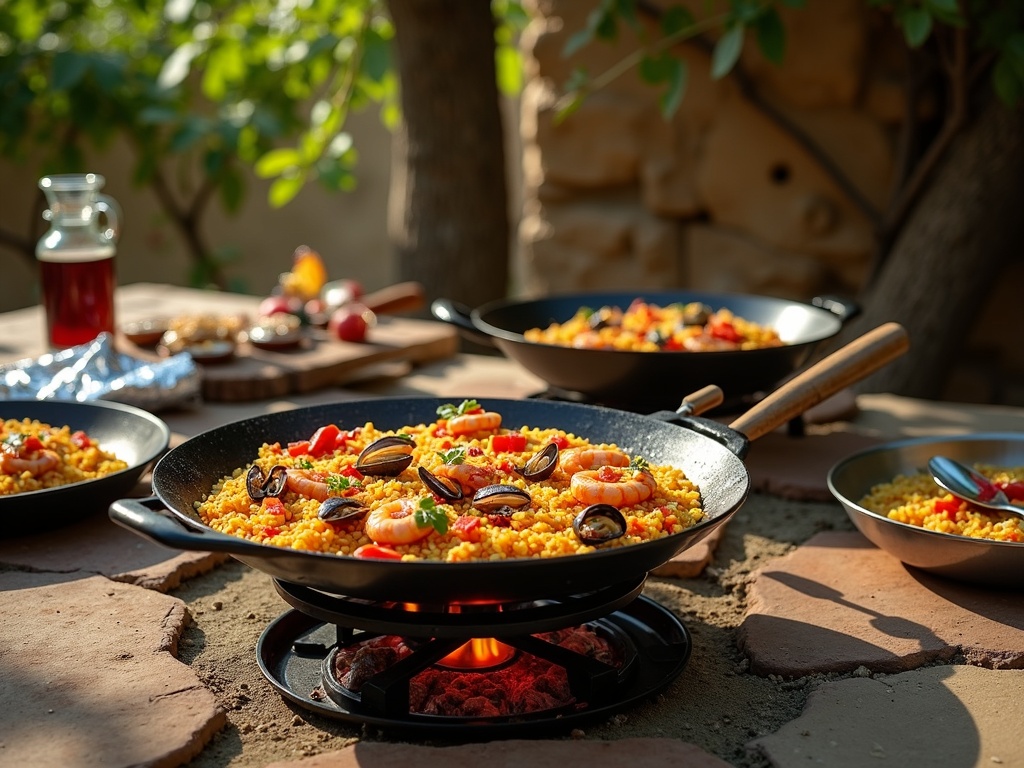
Preparing Your Ingredients
Before diving into cooking paella, I need to make sure all my ingredients are properly prepared. The right preparation is what sets apart an average paella from an exceptional one.
Rice and Seafood Preparation
Measuring rice correctly is critical for paella’s signature texture. I use 1/2 cup of short-grain rice (preferably Spanish bomba or Calasparra) per person. This measurement ensures the perfect balance – enough rice to absorb the flavorful broth without becoming mushy.
When working with seafood, proper cleaning techniques make all the difference. For shrimp, I:
- Remove the heads and shells (keeping them for stock)
- Devein by making a shallow cut along the back
- Rinse briefly under cold water
- Pat dry with paper towels
For mussels and clams, I scrub the shells under cold water and remove the “beard” from mussels by pulling it toward the hinge of the shell. I always discard any shellfish that remain open when tapped, as they’re no longer fresh. Fresh squid needs cleaning by removing the head, ink sac, and beak before cutting the body into rings.
Vegetables and Spices
My vegetable preparation starts with dicing onions and bell peppers into uniform pieces to ensure even cooking. I find that 1/4-inch cubes work perfectly for paella. Garlic should be finely minced to distribute its flavor throughout the dish. When adding tomatoes, I grate them on a box grater to create a smooth pulp that blends beautifully into the rice.
For an authentic paella, I create a spice mixture ahead of time. I combine saffron threads, sweet paprika, and a pinch of smoked paprika in a small bowl. Crushing the saffron threads between my fingers releases their essential oils and that distinctive yellow color that’s so characteristic of a great Spanish culinary tradition.
Fresh herbs like rosemary and thyme should be prepared by removing the stems and roughly chopping the leaves. A small bunch of parsley works wonderfully when chopped and sprinkled over the finished dish.
I arrange all ingredients in separate bowls before starting to cook – similar to the French “mise en place” technique. This organization makes the cooking process smoother, especially when I need to add components quickly during critical cooking stages.
When I’m making appetizers like bruschetta alongside my paella, I prepare those ingredients first, allowing me to focus entirely on the main dish during cooking time.
With proper preparation, my paella ingredients are ready to combine into a spectacular dish that captures the essence of Spanish coastal cuisine.
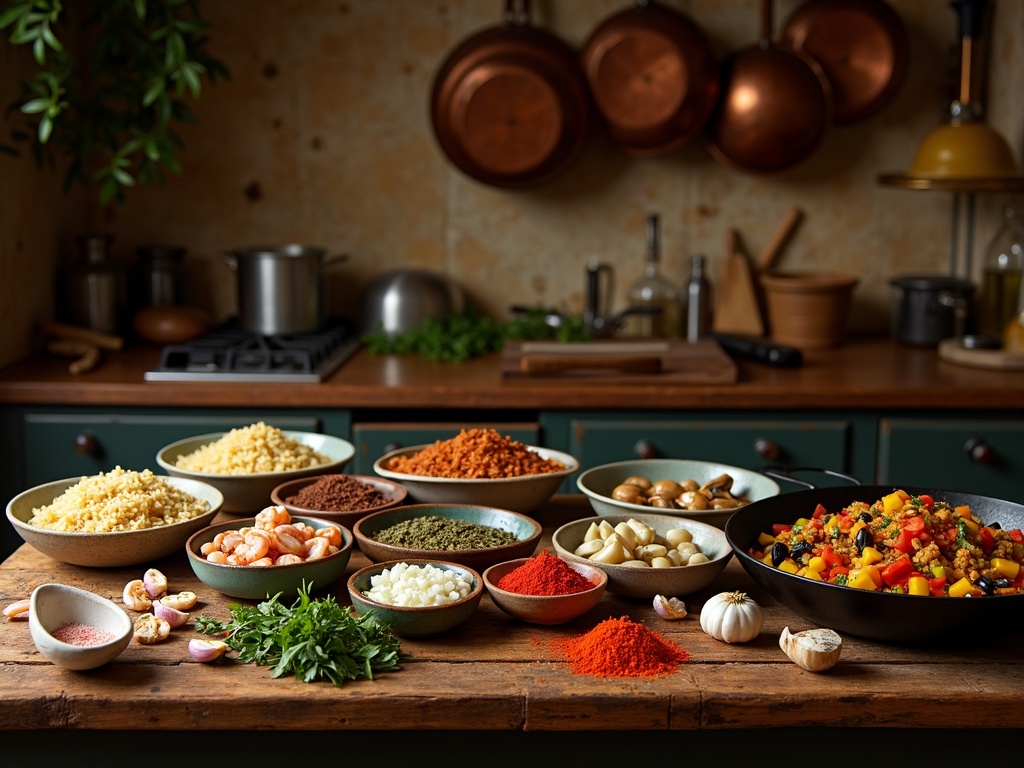
Step-by-Step Cooking Guide
Creating authentic paella requires technique and patience, but the reward is a delicious meal that’s perfect for gatherings. I’ve broken down the process into manageable stages to help you create restaurant-quality paella at home.
Building the Perfect Foundation
The secret to exceptional paella starts with a proper sofrito base. This aromatic foundation sets the tone for your entire dish:
- Heat 1/4 cup olive oil in your paella pan over medium heat until it shimmers.
- Add finely diced onions and sauté until translucent, about 5 minutes.
- Mix in minced garlic and cook until fragrant, roughly 30 seconds.
- Incorporate grated fresh tomatoes and let the mixture slowly caramelize.
- Season with a pinch of salt and add a small bunch of saffron threads to bloom in the hot oil.
This sofrito process can’t be rushed—it takes 15-20 minutes to develop those deep flavors that will infuse your rice.
When your sofrito is ready, it’s time to add the rice. Spanish bomba rice is traditional, but Arborio can work in a pinch. Spread the rice evenly across the pan and toast it for 2-3 minutes, stirring occasionally to coat each grain with the sofrito mixture. This toasting step is crucial as it helps the rice maintain its integrity during cooking, resulting in distinct grains rather than a mushy texture.
For the liquid component, add hot stock gradually, ideally using a homemade variety enhanced with seafood shells or chicken bones. Pour the hot liquid all at once over the rice, being careful not to stir after this point. Season with smoked paprika, salt, and any additional spices your recipe calls for. The liquid-to-rice ratio is important—typically 3:1 for bomba rice, but this may vary depending on your specific rice variety.
Adding Proteins and Vegetables
With your base established, it’s time to arrange your proteins and vegetables. Traditional Valencian paella features rabbit and snails, while seafood variations like chicken and shellfish are popular in coastal regions. Position these ingredients strategically:
- Nestle proteins partially into the cooking rice.
- Arrange vegetables decoratively on top.
- For seafood paella, add quick-cooking items like shrimp during the final 5-10 minutes.
As your paella cooks, resist the temptation to stir! Authentic paella develops its layers of flavor through undisturbed cooking. Cover with foil if needed to ensure even cooking, especially for larger proteins.
Perfecting the Socarrat
The final—and perhaps most important—stage is creating the socarrat, that coveted crispy layer at the bottom. To achieve this:
- Listen for a subtle crackling sound from the pan.
- Increase the heat slightly for the final 1-2 minutes of cooking.
- Remove from heat at the first sign of toasting (but before burning).
- Let the paella rest, covered with a clean kitchen towel, for 5-10 minutes.
This resting period allows the flavors to meld and the rice to absorb any remaining liquid. The socarrat continues to develop during this time, creating that characteristic contrast between the crispy bottom and tender rice above.
Different regions in Spain have their own traditional approaches to paella, so don’t be afraid to experiment with various ingredient combinations while maintaining these fundamental techniques. The beauty of paella lies in its versatility—you can easily adapt it to showcase seasonal produce or accommodate dietary preferences.
Once your paella has rested, bring the entire pan to the table for a dramatic presentation. Traditional serving style involves eating directly from the pan, starting from the edges and working toward the center where the rice is most flavorful.
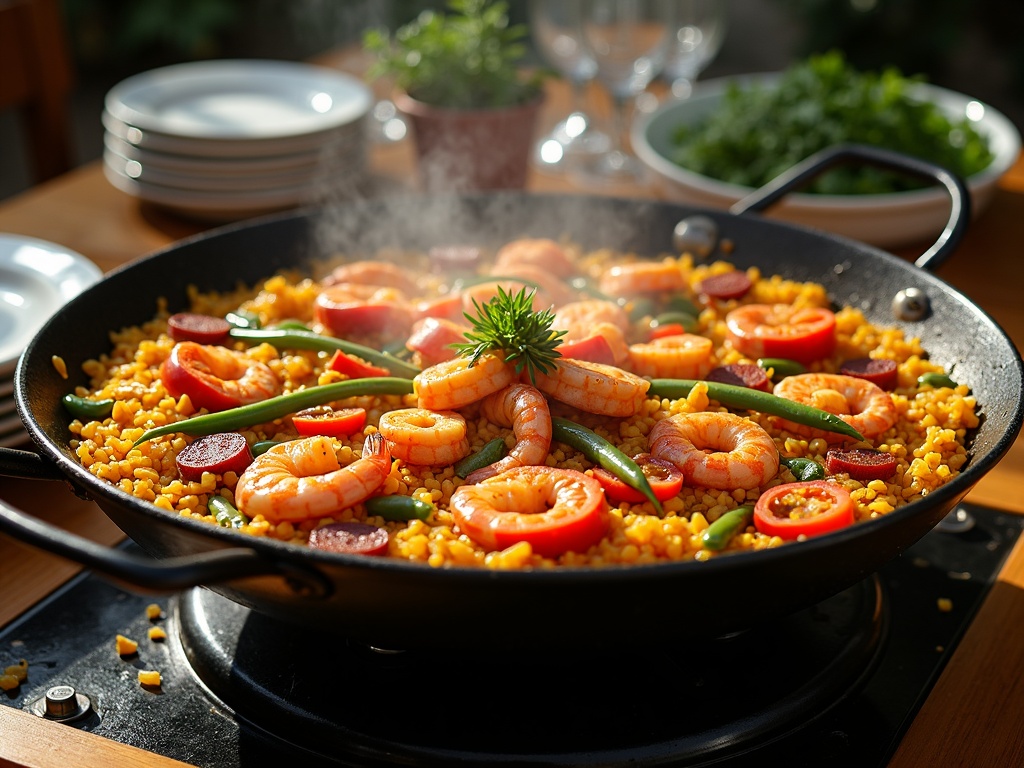
Common Mistakes to Avoid
I’ve learned through many attempts at making paella that small details can make or break this iconic Spanish dish. Avoiding these pitfalls will help you create an authentic paella that captures the true essence of this beloved rice dish.
Rice Selection and Handling Errors
Using the wrong type of rice is perhaps the most critical mistake in paella preparation. Bomba rice is the gold standard for paella due to its ability to absorb liquid while maintaining its structure. Arborio or other risotto rices create a creamy consistency rather than the distinct separate grains typical of a good paella. This fundamental difference affects both texture and flavor, similar to how the right tomatoes make all the difference in authentic gazpacho.
Stirring after adding stock goes against paella tradition. Unlike risotto, paella develops its character from the rice cooking undisturbed. When you add the stock, resist the urge to stir! This allows the bottom layer to form the treasured socarrat—that caramelized crust that adds depth of flavor. The contrast between this crispy bottom and tender rice above creates paella’s distinctive texture profile, much like the layered flavors in a good ratatouille recipe.
Overcrowding the pan distributes heat unevenly and prevents proper evaporation. The ideal paella has rice spread thin (about half an inch) across the pan’s surface. Too many ingredients or too much rice in proportion to your pan size leads to inconsistent cooking. Some areas might be perfect while others remain raw or mushy.
Heat management problems can derail even the most carefully prepared ingredients. Paella requires an initial high heat to sauté aromatics and proteins, then a gradual reduction as the rice cooks. Many cooks maintain the initial high heat throughout, resulting in burned bottoms rather than the desired socarrat. Others reduce heat too much, leaving them with soggy rice that never develops character.
These cooking techniques apply to many Spanish dishes beyond paella—mastering heat control will serve you well when preparing other Mediterranean appetizers like bruschetta too.
By avoiding these common mistakes, I’ve found my paella results have improved dramatically. The perfect paella balances distinct flavors and textures while honoring traditional techniques that have evolved over centuries.
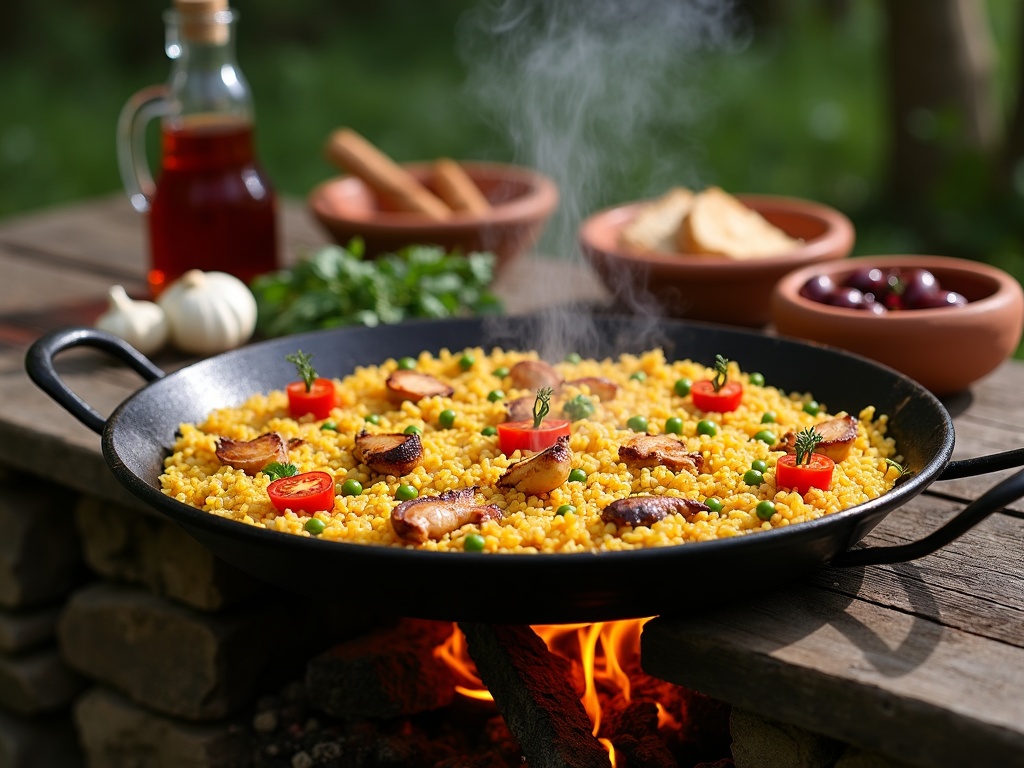
Expert Tips for Perfect Paella
Creating authentic paella requires attention to detail and proper technique. I’ve gathered several key tips that will elevate your paella from good to exceptional, focusing on elements that many home cooks overlook.
Mastering the Fundamentals
Achieving the perfect rice texture is essential for authentic paella. I recommend using Spanish bomba or calasparra rice, which absorbs more liquid without becoming mushy. The secret lies in not stirring the rice once you’ve added the stock – this allows the coveted socarrat (crispy bottom layer) to form. Instead of the fluffy consistency you’d want in other rice dishes, aim for each grain to remain separate yet tender.
Timing the addition of proteins can make or break your paella. I add proteins in stages based on their cooking times:
- Start with chicken pieces, browning them well before adding the rice
- Seafood like shrimp goes in about 8-10 minutes before the end of cooking
- Mussels and clams should be added last, positioning them hinge-side down so they open upward
Stock temperature plays a crucial role in proper rice development. Always add hot stock to maintain an even cooking temperature throughout. Cold stock not only extends cooking time but can result in unevenly cooked rice. I keep my stock simmering in a separate pot, adding it carefully to maintain consistent heat.
For serving, presentation makes a dramatic difference in the paella experience. I bring the entire pan to the table, allowing guests to appreciate the dish’s visual appeal. Traditional serving includes:
- Lemon wedges arranged around the paella’s edge
- Fresh parsley sprinkled just before serving
- Small bowls of chilled gazpacho as a refreshing accompaniment
The best paella has contrasting textures – tender rice, slightly firm vegetables, and perfectly cooked proteins. I sometimes add a final drizzle of high-quality olive oil just before serving to enhance flavors and add a subtle richness to complement spicier rice dishes like this one.
Remember that authentic paella doesn’t need constant attention – once assembled, it mostly cooks undisturbed, allowing you to prepare a simple bruschetta appetizer while your main dish perfects itself.
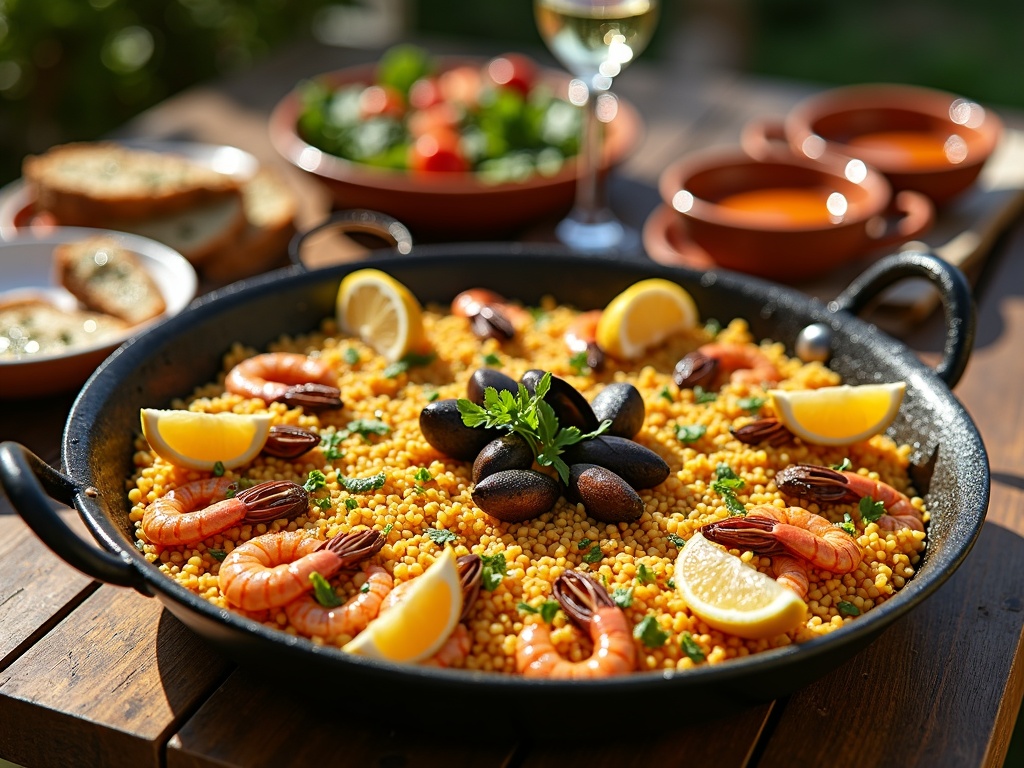
Storage and Reheating
After creating a delicious paella, knowing how to store and reheat your leftovers properly ensures you can enjoy this Spanish classic for days to come. I’ve found that with the right techniques, paella can maintain its flavors and textures almost as well as when freshly made.
Cooling and Storage Guidelines
Proper cooling is essential before storing paella to prevent bacterial growth. I always let my paella cool to room temperature for no more than two hours before refrigeration. To speed up the cooling process safely, I transfer the paella from the wide pan to smaller containers with greater depth-to-surface ratios.
When it comes to containers, airtight options work best for preserving paella’s distinct flavors. Glass containers with secure lids are my top choice as they don’t absorb odors or stain like plastic alternatives might. If you’re planning to freeze portions, I recommend using freezer-safe containers or heavy-duty freezer bags with the air pressed out to minimize freezer burn.
Storage duration varies depending on your method:
- Refrigerated paella stays good for 3–4 days when properly stored
- Frozen paella maintains quality for up to 1 month
- Seafood versions should be consumed within 2 days if refrigerated
The rice in paella tends to continue absorbing liquid during storage, so I sometimes add a tablespoon of water or broth when reheating to restore moisture. For particularly special occasions, I might make a refreshing gazpacho to serve alongside reheated paella, creating a complete Spanish meal experience.
Effective Reheating Methods
Reheating paella requires care to avoid drying out the rice or overcooking the proteins. I’ve tested several methods and found these work best:
- Stovetop reheating creates results closest to fresh paella. I add a splash of broth or water to a non-stick pan, introduce the cold paella, and cover with a lid. Heating over medium-low heat for 5–7 minutes while occasionally stirring helps distribute heat evenly without scorching.
- Microwave reheating works for single portions when you’re short on time. I place the recipe in a microwave-safe dish, sprinkle with water or broth, cover with a damp paper towel, and heat in 1-minute intervals, stirring between each until thoroughly heated.
- Oven reheating works wonderfully for larger portions. I preheat to 350°F, place the paella in an oven-safe dish, add 2–3 tablespoons of liquid, cover with foil, and heat for 15–20 minutes until the internal temperature reaches 165°F.
For the best texture when reheating frozen recipe, I recommend thawing it overnight in the refrigerator before using any of these methods. This helps maintain the integrity of the rice grains and prevents uneven heating.
I find that pairing reheated paella with freshly made sides like bruschetta or a simple salad helps elevate the meal, making leftovers feel special. The contrasting textures and temperatures create an enjoyable dining experience even on the second or third day.
Remember that seafood components like shrimp or mussels may toughen slightly when reheated. In cases where I know I’ll have leftovers, I sometimes reserve a portion of the seafood before it’s fully cooked, then add it during reheating to maintain better texture.
Make-Ahead Instructions
I’ve found that paella doesn’t have to be a last-minute scramble in the kitchen. With some smart prep work, you can create this Spanish masterpiece without the stress. By breaking down the process into manageable steps, even a complex dish like paella becomes accessible for busy home cooks.
Prepping Components in Advance
The secret to a stress-free paella experience lies in advance preparation of key components:
- Sofrito base: I prepare the aromatic base (onions, garlic, and tomatoes) up to 2 days ahead and store it in an airtight container in the refrigerator. This fundamental flavor base develops even more depth when made in advance.
- Proteins: I clean and cut proteins like chicken, seafood, or chorizo the day before. For seafood specifically, I keep it in the coldest part of my refrigerator and use within 24 hours.
- Vegetables: Chopped bell peppers, green beans, and artichokes can be prepped and stored in separate containers for up to 2 days.
- Stock: The saffron-infused broth can be made up to 3 days ahead and refrigerated. This actually allows the saffron to fully release its flavor and color.
- Spice mixture: I measure and mix spices like paprika, saffron, and herbs in a small container ready for use.
By tackling these components separately, I transform what might seem like an overwhelming dish into a series of simple tasks.
Storage and Final Assembly Tips
Proper storage maintains the quality of your prepped ingredients until cooking day. I’ve found these methods most effective:
- Store proteins in the refrigerator in sealed containers with paper towels to absorb excess moisture. This prevents seafood and meat from becoming waterlogged.
- For the day of cooking, I take all prepped ingredients out of the refrigerator about 30 minutes before cooking to bring them closer to room temperature. This ensures more even cooking, particularly important for seafood and chicken.
The final assembly follows a specific order that preserves the integrity of each ingredient. I start by heating my paella pan until very hot before adding oil and sautéing the sofrito. Next come the proteins that take longest to cook, followed by rice, then stock. I add quicker-cooking seafood and vegetables later in the process.
For make-ahead paella, I sometimes cook the dish partially (about 75% done) earlier in the day, then finish the final cooking right before serving. This works particularly well when I’m entertaining guests and want to focus on hosting rather than cooking.
Time-Saving Shortcuts
Time-saving shortcuts can make paella more accessible without sacrificing authentic flavor:
- High-quality store-bought stock enhanced with saffron and other seasonings replicates homemade broth with minimal effort.
- Pre-chopped frozen vegetables work well in paella, particularly peas and bell peppers.
- Vacuum-sealed cooked seafood like mussels can be added in the final minutes of cooking.
- Quick-cooking rice varieties specially designed for paella reduce cooking time by 5–10 minutes.
When planning to make components ahead, timing matters. The rice should always be cooked fresh, but almost everything else can be prepared in advance. On serving day, I allow about 45 minutes for final assembly and cooking of a traditional paella, regardless of how much prep was done ahead of time.
With these make-ahead strategies, paella becomes a practical option not just for special occasions but for regular weeknight dinners too. The dish actually benefits from this methodical approach, as flavors have time to develop and the final cooking process becomes focused on technique rather than frantic chopping and measuring.

